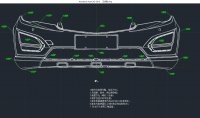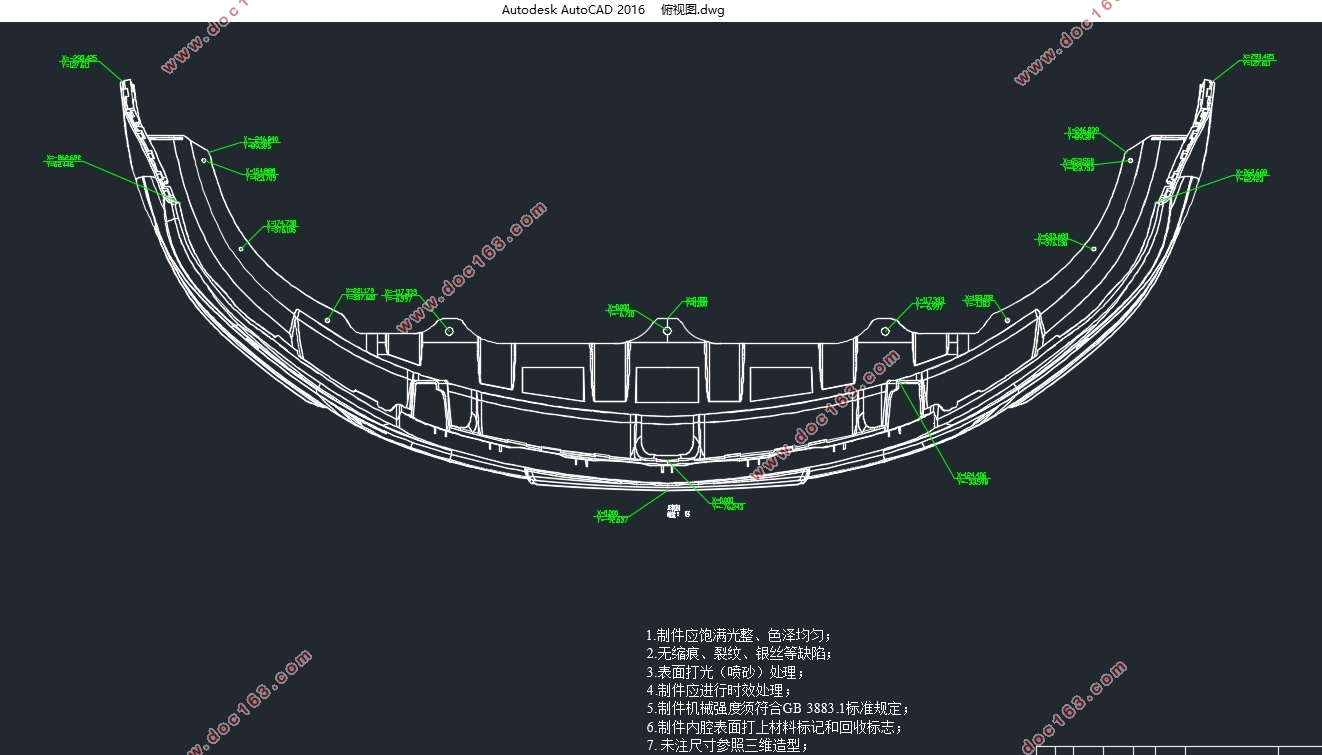汽车保险杠蒙皮结构设计及性能分析(含CAD图)

汽车保险杠蒙皮结构设计及性能分析(含CAD图)(任务书,开题报告,文献摘要,外文翻译,论文说明书20000字,CAD图2张)
摘要
随着中国汽车总量的不断增加,城市交通变得越来越拥挤,汽车低速碰撞频发,如何提高汽车的被动安全性能和减少汽车发生碰撞后的维修费用,也成为汽车安全领域的研究热门。本文根据汽车保险杠系统发生低速碰撞的特点,使用有限元仿真技术对某款汽车前保险杠蒙皮进行静态特性研究和低速碰撞性能研究。首先经过对保险杠蒙皮的主要受力部位施加一系列的静态载荷,验证了保险杠蒙皮的静态特性,并对蒙皮进行了优化设计;其次,通过建立的前保险杠蒙皮的低速碰撞模型,对前保险杠蒙皮进行低速碰撞仿真实验,通过实验验证了保险杠蒙皮的碰撞特性;并根据有限元仿真的结果,对蒙皮的材料和厚度进行了轻量化设计并进行了验证,最终得出新的保险杠蒙皮的静态特性与碰撞特性与原保险杠蒙皮相当,满足使用要求。
首先使用曲面设计软件catia建立保险杠蒙皮的几何模型,并对蒙皮进行结构简化和模型清理,然后将模型导入有限元建模软件 hypermesh,对蒙皮模型进行修理、抽取中面、网格划分、检查网格质量,完成有限元模型建立的前处理工作。之后分两种方法进行研究,一是对保险杠蒙皮进行静力受力分析,首先建立材料模型和材料属性,然后对蒙皮施加载荷和约束,定义载荷步,定义选项卡,并将建立好的有限元模型导入Optistruct求解器进行求解,应用hyperview对蒙皮仿真结果进行分析;二是对保险杠蒙皮进行低速碰撞分析,建立蒙皮与小腿的有限元模型,依次建立材料属性、施加约束、定义接触、沙漏控制等,然后将建立的仿真模型导出为Ls-dyna格式的key文件,使用Ls-dyna求解器对有限元模型进行求解,应用 hyperview对碰撞仿真结果进行分析。最后,根据对蒙皮有限元模型的分析,分析蒙皮哪些方面不满足设计要求,并对这些缺陷使用先进的轻量化方法,对蒙皮的模型进行重新设计,然后对蒙皮进行有限元仿真分析,使改进后的蒙皮最终满足使用要求,从而得到更好的蒙皮静态特性与碰撞安全性。
关键词:保险杠蒙皮 有限元分析 轻量化
Abstruct
With the increasing of the total Chinese auto, urban traffic is becoming more and more crowded, automobile low-speed collision frequency, how to improve the passive safety of automobile performance and reduce the maintenance costs after the car collision, also became popular in the field of automotive safety research. In this paper, according to the characteristics of low-speed collision occurs, the bumper system using finite element simulation of automobile front bumper skin for static characteristic and low-speed collision performance research. First by applying a series of main mechanical parts of the bumper skin static load, verify the static characteristic of the bumper skin, and the optimization design of skin; Second, through the establishment of low-speed collision model of the bumper skin, low-speed crash simulation experiment was carried out on the bumper, verified by the experiment of the bumper skin collision characteristics; And according to the results of finite element simulation, the optimization design of the material and thickness of the skin and is verified, and finally draw a new bumper skin static characteristic and collision characteristics and the original bumper skin fairly, meets the requirement. [资料来源:www.doc163.com]
First use of three-dimensional modeling software catia to establish a geometric model of the bumper skin, and skin is clear and simplified model structure, then put the model into finite element modeling software hypermesh, repair the skin model, extraction of surface, meshing, check the quality of grid, the finite element model is established in the former work. Points after two kinds of methods, one is the static stress analysis was carried out on the bumper skin, first establish material model and the material properties, and then load and constraints imposed on the skin, define the load step, definition tab, and will build a good finite element model are applied to solve the import Optistruct solver application hyperview analyze the skin simulation results; Second, an analysis of the low-speed collision bumper skin, skin and crus of the finite element model is set up, in order to establish material properties, restrictions, define contact, the hourglass control, etc., and then establish the simulation model is derived for key of ls-dyna format file, using ls-dyna solver to solve the finite element model, application of collision hyperview simulation results are analyzed. Finally, according to the analysis of the bumper skin base model, analyze its does not meet the design requirements of link, using reasonable means of improvement, to improve the basic model, and carries on the finite element simulation analysis, make the skin eventually meet the design requirements, improve the static characteristic of the system safety and collision. [来源:http://Doc163.com]
Keywords: bumper skin The finite element analysis lightweight
[来源:http://www.doc163.com]



目录
第一章 绪论 2
1.1 研究背景 2
1.2蒙皮使用材料研究现状 3
1.3汽车碰撞的的主要研究方法 4
1.4课题研究目的和内容 5
1.5本章小结 6
第二章. 有限元仿真分析的理论基础及建模 7
2.1有限元软件的发展 7
2.2有限元软件概述 7
2.3蒙皮分析结果评价 8
2.4 蒙皮的结构 9
2.5蒙皮网格划分 10
2.5.1有限元模型清理 10
2.5.2网格单元大小及类型选择 12
2.5.3单元的质量检验 13
2.6本章小结 13
第三章.蒙皮的性能分析 14
3.1蒙皮有限元模型的建立 14
3.2 静力分析 14
3.3本章小结 20
第四章.蒙皮的动态特性分析 21
4.1碰撞系统模型的建立 21
4.1.1沙漏控制 21
4.1.2材料定义 22
4.1.3接触方式 22
4.1.4边界条件 22
4.2建立有限元模型 22
4.3碰撞结果分析 23
4.4本章小结 28
第五章.结构优化 29
5.1材料优化 29
5.2厚度优化 34
5.2.1连接受力分析 34
5.2.2正面受力分析 35
5.2.3动态特性分析 35
5.3本章小结 37
第六章.总结与展望 38
6.1总结 38
6.2展望 38
参考文献 40
致谢 42
[资料来源:https://www.doc163.com]
下一篇:汽车主动悬架系统设计与仿真研究(含CAD图,CATIA三维图)
